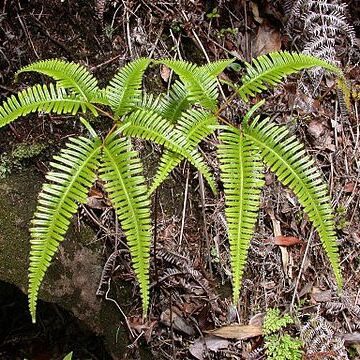Rhizome long-creeping, bearing septate, branched (at least basally) hairs; roots with very narrow linear cells. Stipes scattered along rhizome. Fronds complex, erect or scandent, consisting of 1–many tiers of opposite, primary branches with dormant, vegetative buds between them, each repeatedly divided; branch pairs equal or unequal; buds protected by short, erect, ovate to pectinately-pinnatifid leaflets; a pair of deflexed, accessory branches, consisting of a lamina like that of penultimate segments sometimes present on outside of ultimate forks and just above them; penultimate segments divided almost to midrib. Ultimate segments entire; venation open, dichotomous; ultimate veins at least twice-forked. Sori of 5–15 sporangia in 2 two rows on either side of midrib, 1 (rarely 2) to each ultimate vein group; sporangia not mixed with paraphyses. Spores trilete and tetrahedral (subg. Dicranopteris ) or monolete and ellipsoidal (subg. Acropterygium, not in Australia).
Rhizomes slender, long creeping, covered with multicellular hairs. Fronds distant, erect or somewhat scandent; rachis often several times dichotomously branched with dormant buds in dichotomies, with normal pinnules only at apex, each dichotomy usually with a pair of lateral pinnae, these shallowly to more usually deeply pectinately pinnatifid; dormant apical buds covered with stiff hairs, usually subtended by stipulelike bracts; ultimate pinnae deeply pectinately pinnatifid, lanceolate or broadly lanceolate, sessile; lobes horizontally spreading, margin entire or rarely crenate, often narrowly revolute; most veins 2-or 3-forked with (3 or)4-6 veinlets. Sori orbicular, exindusiate, in 1(-3) line on each side of costule; sporangia 6-18, sessile; spores tetrahedral [or ellipsoid], without perispore, smooth.
Stems long-creeping; hairs many celled, rigid to lax. Leaves usually separated several centimeters, of apparently indeterminate growth; pinnae opposite, in 1--several pairs, each pinna 1--many times forked, equal, each fork bearing arrested apex (bud) covered with tuft of hairs (all other axes glabrous) and pair of stipulelike appendages. Penultimate segments pectinate, in ± equal pairs, usually ascending. Veins 2--4-forked. Sori with 6--15 or more sporangia, not paraphysate. Spores trilete.

